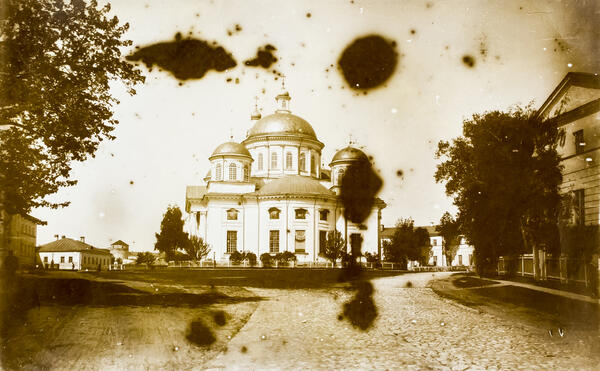The photograph depicting the Cathedral of the Kazan Icon of the Mother of God was taken by an unknown photographer in the 20th century. By that time, the temple had already experienced many events, including a complete reconstruction after dilapidation.
The place where the building was erected is considered sacred. Legend has it that it was chosen by the Mother of God herself: it was there in 1579 that the girl Matrona found the famous Kazan icon.
First, the construction workers built a wooden church of the Most Holy Theotokos. At the entrance to the museum, you can see its miniature copy: it clearly demonstrates how the tent roof architecture looked like, and how logs used to be joined without a single nail in those times.
However, the first wooden church did not exist for a long time: already in April 1594, the architects laid the foundation for a stone church in accordance with the order of Tsar Fyodor Ioannovich. It was decorated with two side altars: one was consecrated n the name of the Assumption of the Most Holy Theotokos, the second — in the name of the Saint Prince Alexander Nevsky. The building was consecrated in the fall of 1595. At the same time, Fyodor Ioannovich ordered to supply the church with icons, books, arrange a sacristy (a special room for storing church utensils), and decorate the Kazan icon itself with gold, gems and pearls from the royal treasury.
Unfortunately, only two centuries later, the church fell into disrepair: stones fell from the walls and even from the vaults. Therefore, the Archbishop of Kazan decided to dismantle the old church and build a new one in its place. The residents of Kazan and the authorities supported the proposal of the Reverend Ambrose: in 1796 the workers pulled the building down.
On June 12, 1798, the builders laid the foundation for a new church in the Imperial presence of Emperor Pavel Petrovich. The renewed architectural design and facade had been proposed by the architect Ivan Starov, one of the founders of Classicism in Russian architecture. Thanks to him, the building became the earliest and best example of mature Classicism in Kazan; it played an important role in the development of this style in the city.
By the beginning of the twentieth century, the temple of the Kazan Icon of the Mother of God was one of the best in the entire Kazan Diocese. It was decorated with five high domes with crosses gilded by fire processing, as well as with various elements from antique architecture. The photo shows the cathedral from the side of the altar — the abbesses and the most honorable citizens were traditionally buried behind it.
Unfortunately, during the Soviet era, the temple was destroyed again. Today the residents of Kazan admire its restored version.
The place where the building was erected is considered sacred. Legend has it that it was chosen by the Mother of God herself: it was there in 1579 that the girl Matrona found the famous Kazan icon.
First, the construction workers built a wooden church of the Most Holy Theotokos. At the entrance to the museum, you can see its miniature copy: it clearly demonstrates how the tent roof architecture looked like, and how logs used to be joined without a single nail in those times.
However, the first wooden church did not exist for a long time: already in April 1594, the architects laid the foundation for a stone church in accordance with the order of Tsar Fyodor Ioannovich. It was decorated with two side altars: one was consecrated n the name of the Assumption of the Most Holy Theotokos, the second — in the name of the Saint Prince Alexander Nevsky. The building was consecrated in the fall of 1595. At the same time, Fyodor Ioannovich ordered to supply the church with icons, books, arrange a sacristy (a special room for storing church utensils), and decorate the Kazan icon itself with gold, gems and pearls from the royal treasury.
Unfortunately, only two centuries later, the church fell into disrepair: stones fell from the walls and even from the vaults. Therefore, the Archbishop of Kazan decided to dismantle the old church and build a new one in its place. The residents of Kazan and the authorities supported the proposal of the Reverend Ambrose: in 1796 the workers pulled the building down.
On June 12, 1798, the builders laid the foundation for a new church in the Imperial presence of Emperor Pavel Petrovich. The renewed architectural design and facade had been proposed by the architect Ivan Starov, one of the founders of Classicism in Russian architecture. Thanks to him, the building became the earliest and best example of mature Classicism in Kazan; it played an important role in the development of this style in the city.
By the beginning of the twentieth century, the temple of the Kazan Icon of the Mother of God was one of the best in the entire Kazan Diocese. It was decorated with five high domes with crosses gilded by fire processing, as well as with various elements from antique architecture. The photo shows the cathedral from the side of the altar — the abbesses and the most honorable citizens were traditionally buried behind it.
Unfortunately, during the Soviet era, the temple was destroyed again. Today the residents of Kazan admire its restored version.



